Effects of Blade Suction Side Modification on Internal Flow Characteristics and Hydraulic Performance in a PIV Experimental Centrifugal Pump
Abstract
1. Introduction
2. Model Pump and PIV System
2.1. Model Pump and TE Modification
2.2. Experimental Setup
2.3. PIV Setup
3. Results and Discussions
3.1. Hydraulic Performances of Different Blades TE Modification
3.2. Velocity Distributions of Different TE Profiles
3.3. Influence of Blade Trailing Edges near the Outlet
3.4. Effects of Different TE Profiles on Slip Factor
3.5. Effects of Different TE Profiles on Nominalized Local Euler Head Distribution
4. Conclusions
- An appropriate increase in the blade outlet angle in the suction side is beneficial to improve the optimal efficiency and head. When the blade outlet angle increases reasonably, the head and efficiency of ATE1 are greater than those of OTE and ATE2. When the blade outlet angle is too large, the head and efficiency of ATE2 are higher than those of OTE under low flow rate conditions. While under the condition of the high flow rate, the deviation of relative velocity streamlines in ATE2 is caused by the excessive flow passage diffusion, and the hydraulic performance is decreased.
- The TE modification of the blade suction side has a great influence on the internal flow field. There is a backflow vortex A near the suction side at outlet in OTE, which reduces the flow stability of the outlet and causes a decrease in hydraulic performance. The reason is that there is a large-scale backflow vortex structure of OTE at the outlet for most transient moments under deep-low flow rate, and the scale and magnitude are much larger than those of ATEs. Such backflow vortex A does not exist in ATEs since there are only very small backflows at the outlet.
- The TE modification will have an impact on the slip factor. For the same flow rate, OTE has the smallest slip factor, ATE1 has the largest slip factor, and ATE2 is in between. The counterclockwise vortex generated by the backflow vortex A strengthens the velocity slip at the outlet; in that case, the slip factor of OTE is smaller than that of ATEs. In the wake region, the overall slip factor of ATE1 is larger than that of ATE2. Since the blade profile of the suction side of ATE2 and ATE1 are S-shaped, of ATE2 will become larger compared to ATE1, resulting in the increase in slip velocity, and slip factor decreases near the suction side.
- After TE modification, the LEHs of ATEs are significantly higher than that of OTE, and those become larger as the flow rate decreases. The NLEHD reflects the energy growth from LE to TE for different blade trailing edges, and the deviation degree from the constant growth rate dashed line can well reflect the energy conversion ability of different model pumps. ATE1 has the smallest deviation, OTE has the largest deviation, and ATE2 is in between. It can be concluded that ATE1 has the strongest energy conversion ability and OTE has the weakest energy conversion ability, which is consistent with the hydraulic performance.
- The slip factor and the NLEHD are used to judge the energy conversion strength of different model pumps from two aspects: outlet (partial) and inlet to outlet (overall). It can be concluded that the response of the slip factor and the deviation degree of NLEHD to the energy conversion characteristic are highly consistent. The larger the slip factor and the smaller the deviation degree of the NLEHD are, the stronger the energy conversion ability will be. Additionally, the corresponding hydraulic performance and flow field are also better.
Author Contributions
Funding
Data Availability Statement
Acknowledgments
Conflicts of Interest
References
- Kalaiselvan, A.S.V.; Subramaniam, U.; Shanmugam, P.; Hanigovszki, N. A comprehensive review on energy efficiency enhancement initiatives in centrifugal pumping system. Appl. Energy 2016, 181, 495–513. [Google Scholar]
- Wu, C.S.; Pu, K.X.; Li, C.Q.; Wu, P.; Huang, B.; Wu, D.Z. Blade redesign based on secondary flow suppression to improve energy efficiency of a centrifugal pump. Energy 2022, 246, 123394. [Google Scholar] [CrossRef]
- Guo, C.; Gao, M.; Wang, J.Y.; Shi, Y.T.; He, S.Y. The effect of blade outlet angle on the acoustic field distribution characteristics of a centrifugal pump based on Powell vortex sound theory. Appl. Acoust. 2019, 15, 297–308. [Google Scholar] [CrossRef]
- Luo, X.W.; Zhang, Y.; Peng, J.Q.; Xu, H.Y.; Yu, W.P. Impeller inlet geometry effect on performance improvement for centrifugal pumps. J. Mech. Sci. Technol. 2008, 22, 1971–1976. [Google Scholar] [CrossRef]
- Wu, C.S.; Zhang, W.Q.; Wu, P.; Yi, J.L.; Ye, H.J.; Huang, B.; Wu, D.Z. Effects of Blade Pressure Side Modification on Unsteady Pressure Pulsation and Flow Structures in a Centrifugal Pump. J. Fluids Eng. 2021, 143, 111208. [Google Scholar] [CrossRef]
- Gao, B.; Zhang, N.; Li, Z.; Ni, D.; Yang, M.G. Influence of the blade trailing edge profile on the performance and unsteady pressure pulsations in a low specific speed centrifugal pump. J. Fluids Eng. 2016, 138, 051106. [Google Scholar] [CrossRef]
- Wu, D.Z.; Yan, P.; Wu, P.; Yang, S. Effect of trailing-edge modification of a mixed-flow pump. J. Fluids Eng. 2015, 137, 101205. [Google Scholar] [CrossRef]
- Das, S.K. Experimental performance evaluation of a centrifugal pump with different impeller vane geometries. In Proceedings of the ASME 2014 International Mechanical Engineering Congress and Exposition, Montreal, QC, Canada, 14–20 November 2014. [Google Scholar]
- Ni, D.; Yang, M.G.; Bo, G.; Zhang, N.; Li, Z. Numerical study on the effect of the diffuser blade trailing edge profile on flow instability in a nuclear reactor coolant pump. Nucl. Eng. Des. 2017, 322, 92–103. [Google Scholar] [CrossRef]
- Cui, B.L.; Li, W.Q.; Zhang, C.L. Effect of Blade Trailing Edge Cutting Angle on Unstable Flow and Vibration in a Centrifugal Pump. J. Fluids Eng. 2020, 142, 101203. [Google Scholar] [CrossRef]
- Lin, Y.P.; Li, X.J.; Li, B.W.; Jia, X.Q.; Zhu, Z.C. Influence of impeller sinusoidal tubercle trailing-edge on pressure pulsation in a centrifugal pump at nominal flow rate. J. Fluids Eng. 2021, 143, 091205. [Google Scholar] [CrossRef]
- Gülich, J.F. Centrifugal Pumps; Springer: Berlin, Germany, 2010; Chapter 4. [Google Scholar]
- Barrio, R.; Blanco, E.; Parrondo, J.; Gonzalez, J.; Fernandez, J. The Effect of Impeller Cutback on the Fluid-Dynamic Pulsations and Load at the Blade-Passing Frequency in a Centrifugal Pump. J. Fluids Eng. 2008, 130, 111102. [Google Scholar] [CrossRef]
- Ding, H.C.; Li, Z.K.; Gong, X.B.; Li, M.S. The Influence of Blade Outlet Angle on the Performance of Centrifugal Pump with high specific speed. Vacuum 2019, 159, 239–246. [Google Scholar] [CrossRef]
- Liu, X.D.; Li, Y.J.; Liu, Z.Q. Dynamic Stall Inception and Evolution Process Measured by High-Frequency Particle Image Velocimetry System in Low Specific Speed Impeller. J. Fluids Eng. 2022, 144, 041504. [Google Scholar]
- Wang, Y.P.; Yang, H.; Chen, B.; Gao, P.L.; Chen, H.; Zhu, Z.C. Analysis of vortices formed in flow passage of a five-bladed centrifugal water pump by means of PIV method. AIP Adv. 2019, 9, 075011. [Google Scholar] [CrossRef]
- Keller, J.; Blanco, E.; Barrio, R.; Parrondo, J. PIV measurements of the unsteady flow structures in a volute centrifugal pump at a high flow rate. Exp. Fluids 2014, 55, 1820. [Google Scholar] [CrossRef]
- Zhang, N.; Bo, G.; Li, Z.; Ni, D.; Jiang, Q.F. Unsteady flow structure and its evolution in a low specific speed centrifugal pump measured by PIV. Exp. Therm. Fluid Sci. 2018, 97, 133–144. [Google Scholar] [CrossRef]
- Westra, R.W.; Broersma, L.; Andel, K.V.; Kruyt, N.P. PIV Measurements and CFD computations of secondary flow in a centrifugal pump impeller. J. Fluids Eng. 2010, 132, 061104. [Google Scholar] [CrossRef]
- Krause, N.; Zahringer, K.; Pap, E. Time-resolved particle imaging velocimetry for the investigation of rotating stall in a radial pump. Exp. Fluids 2005, 39, 192–201. [Google Scholar] [CrossRef]
- Li, X.J.; Chen, H.; Chen, B.; Luo, X.W.; Yang, B.F.; Zhu, Z.C. Effects of flow pattern on hydraulic performance and energy conversion characterisation in a centrifugal pump. Renew. Energy 2020, 151, 475–487. [Google Scholar] [CrossRef]
- Si, Q.R.; Dupont, P.; Dazin, A.; Roussette, O.; Yuan, S.Q.; Bayeul, A. An Experimental Study of the Flow Field Inside the Diffuser Channel of a Laboratory Centrifugal Pump. J. Fluids Eng. 2015, 137, 061105. [Google Scholar] [CrossRef]
- Pedersen, N.; Larsen, P.S.; Jacobsen, C.B. Flow in a centrifugal pump impeller at design and off-design conditions-Part I: Particle image velocimetry (PIV) and laser Doppler velocimetry (LDV) measurements. J. Fluids Eng. 2003, 125, 61–72. [Google Scholar] [CrossRef]
- Shi, B.C.; Wei, J.J.; Zhang, Y. A novel experimental facility for measuring internal flow of Solid-liquid two-phase flow in a centrifugal pump by PIV. Int. J. Multiph. Flow 2017, 89, 266–276. [Google Scholar] [CrossRef]
- Brennen, C.E. Hydrodynamics of Pumps, Concept ETI; Oxford University Press: Oxford, UK, 1994. [Google Scholar]
- Chen, B.; Li, X.J.; Zhu, Z.C. Time-Resolved Particle Image Velocimetry Measurements and Proper Orthogonal Decomposition Analysis of Unsteady Flow in a Centrifugal Impeller Passage. Front. Energy Res. 2022, 9, 818232. [Google Scholar] [CrossRef]
- Chen, B.; Li, X.J.; Zhu, Z.C. Investigations of energy distribution and loss characterization in a centrifugal impeller through PIV experiment. Ocean Eng. 2022, 247, 110773. [Google Scholar] [CrossRef]
- Stodola, A. Steam and Gas Turbines; McGraw-Hill Book Co.: New York, NY, USA, 1945. [Google Scholar]
- Li, X.J.; Chen, H.; Chen, B.; Luo, X.W.; Yang, B.F.; Zhu, Z.C. Investigation of flow pattern and hydraulic performance of a centrifugal pump impeller through the PIV method. Renew. Energy 2020, 162, 561–574. [Google Scholar]
- Yan, P.; Chu, N.; Wu, D.Z.; Cao, L.L.; Yang, S.; Wu, P. Computational fluid dynamics-based pump redesign to improve efficiency and decrease unsteady radial forces. J. Fluids Eng. 2017, 139, 011101. [Google Scholar] [CrossRef]

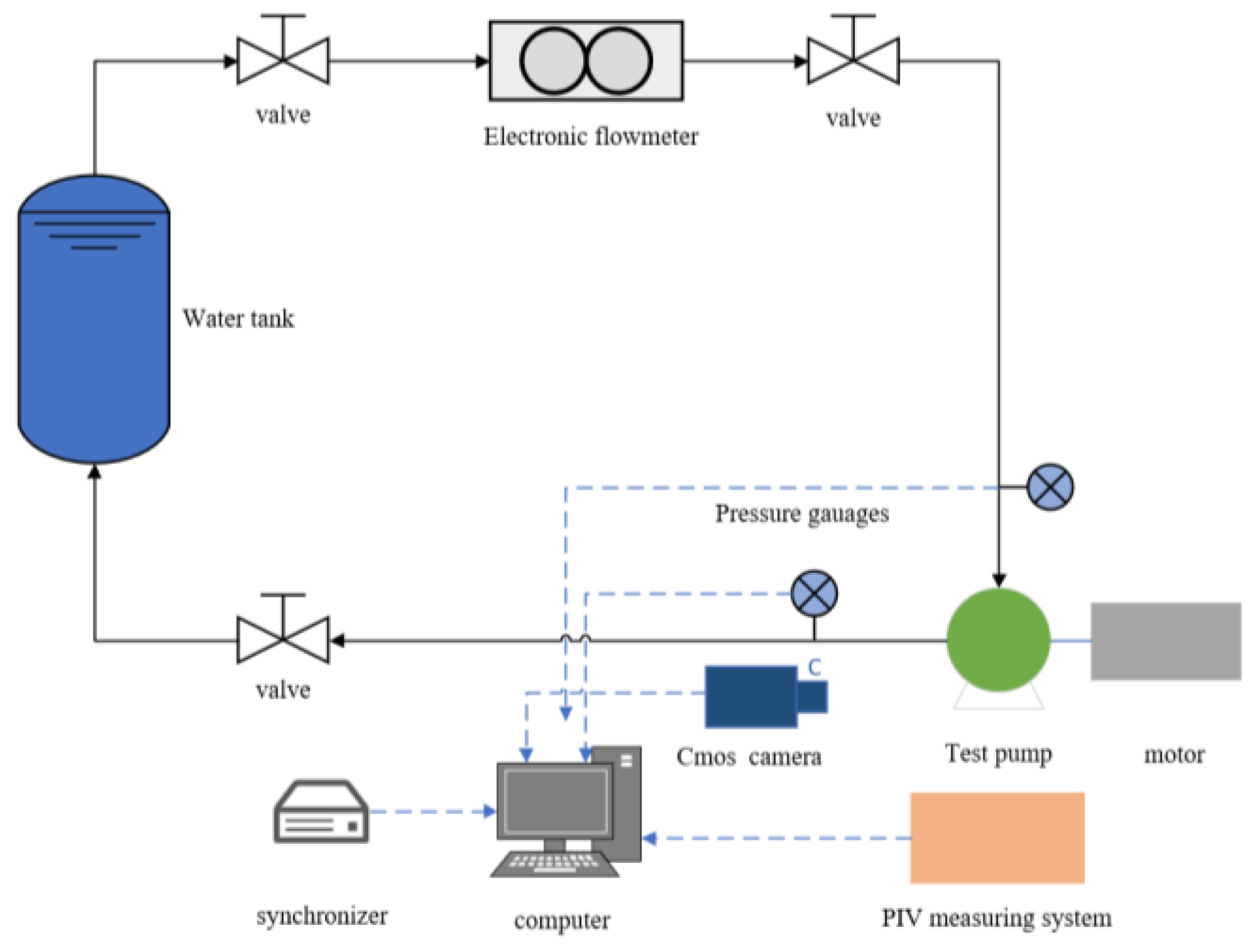
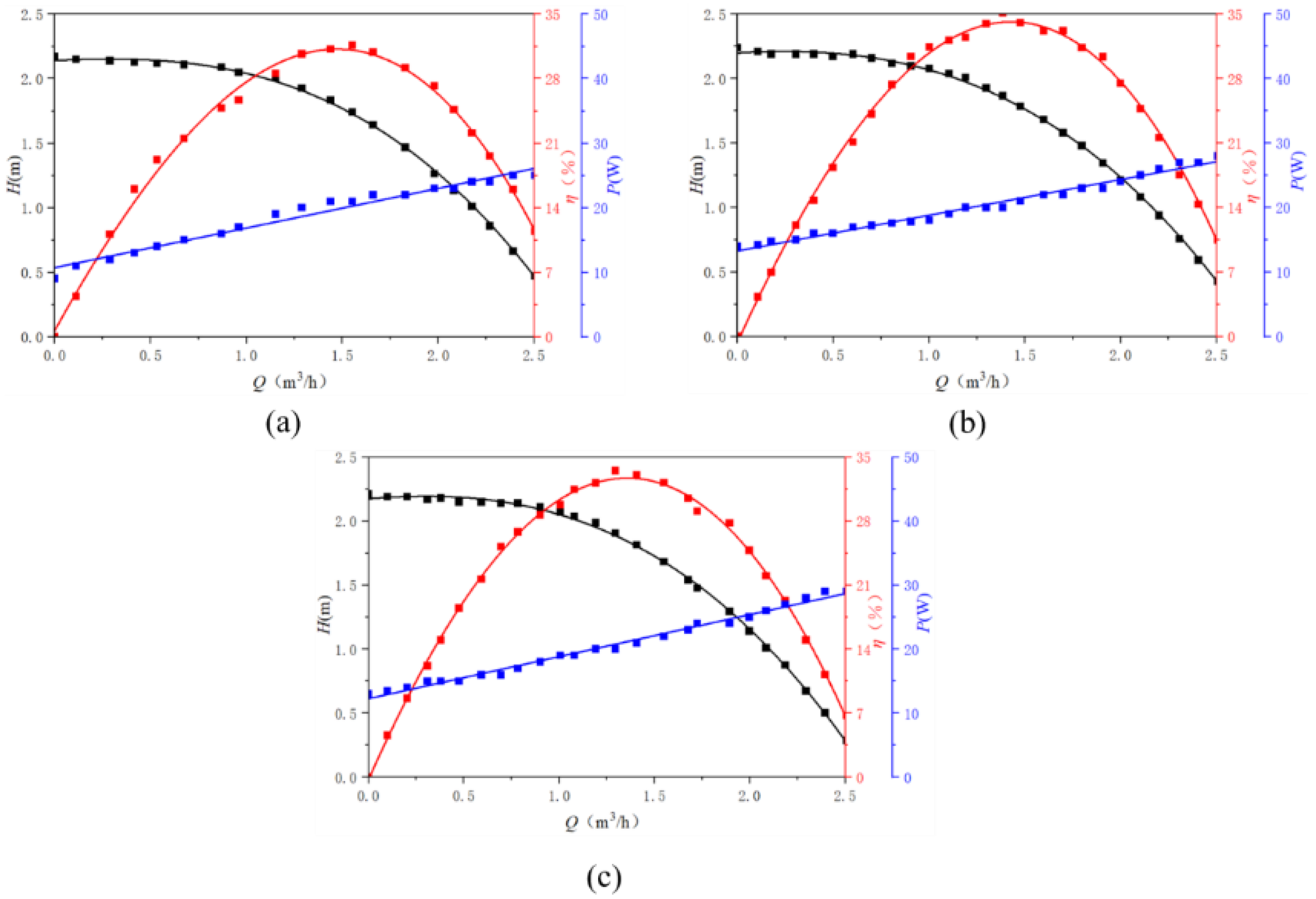



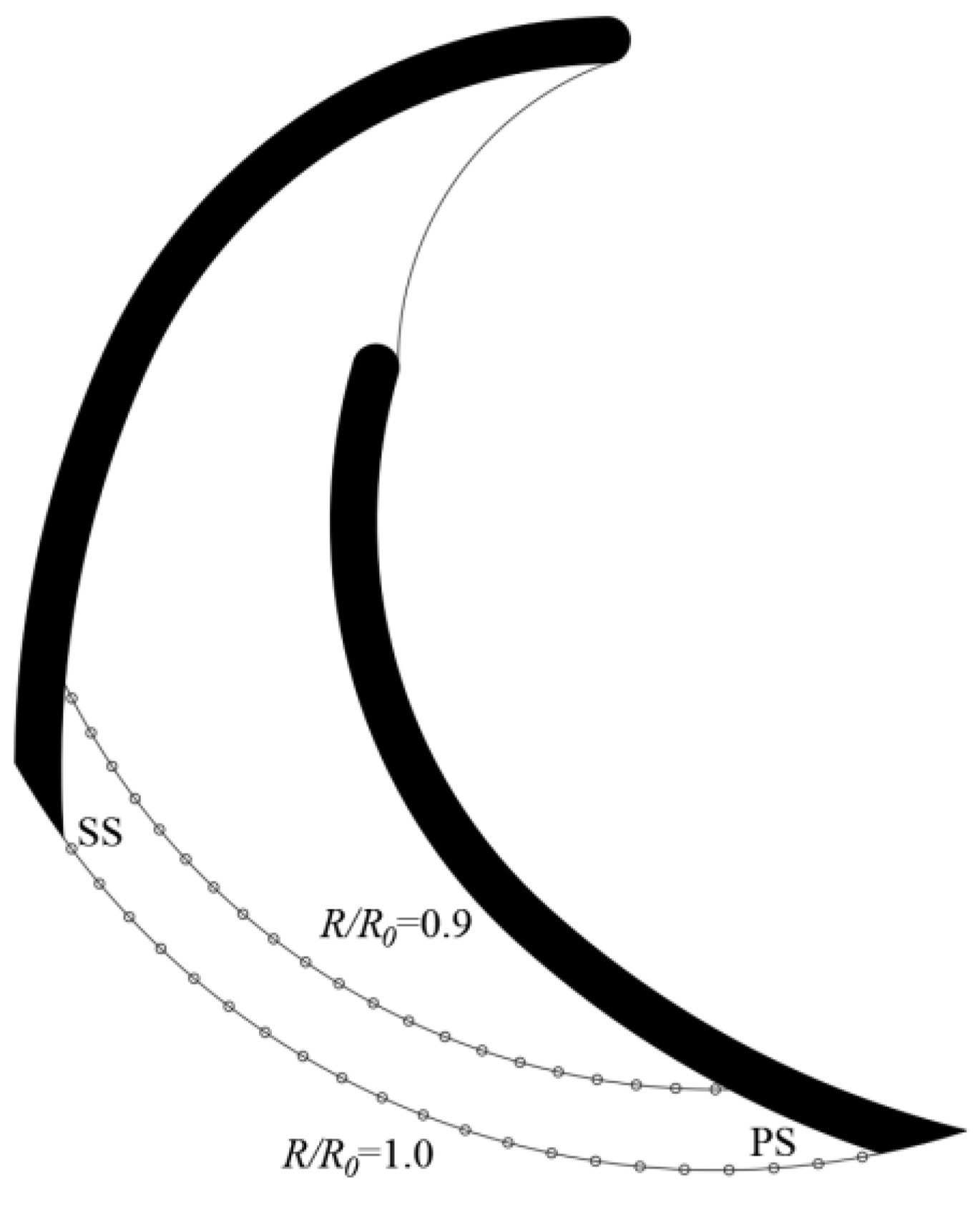
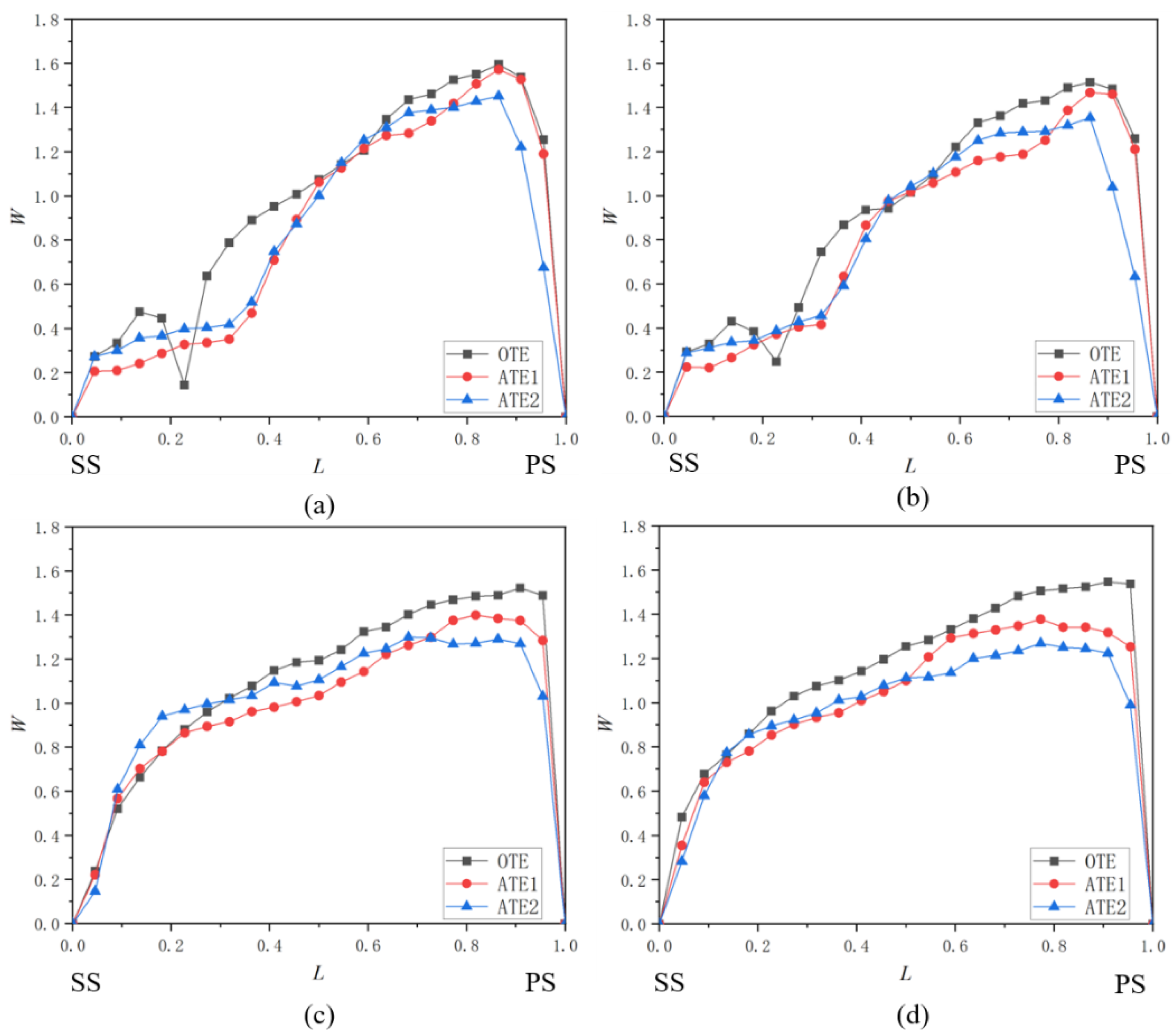
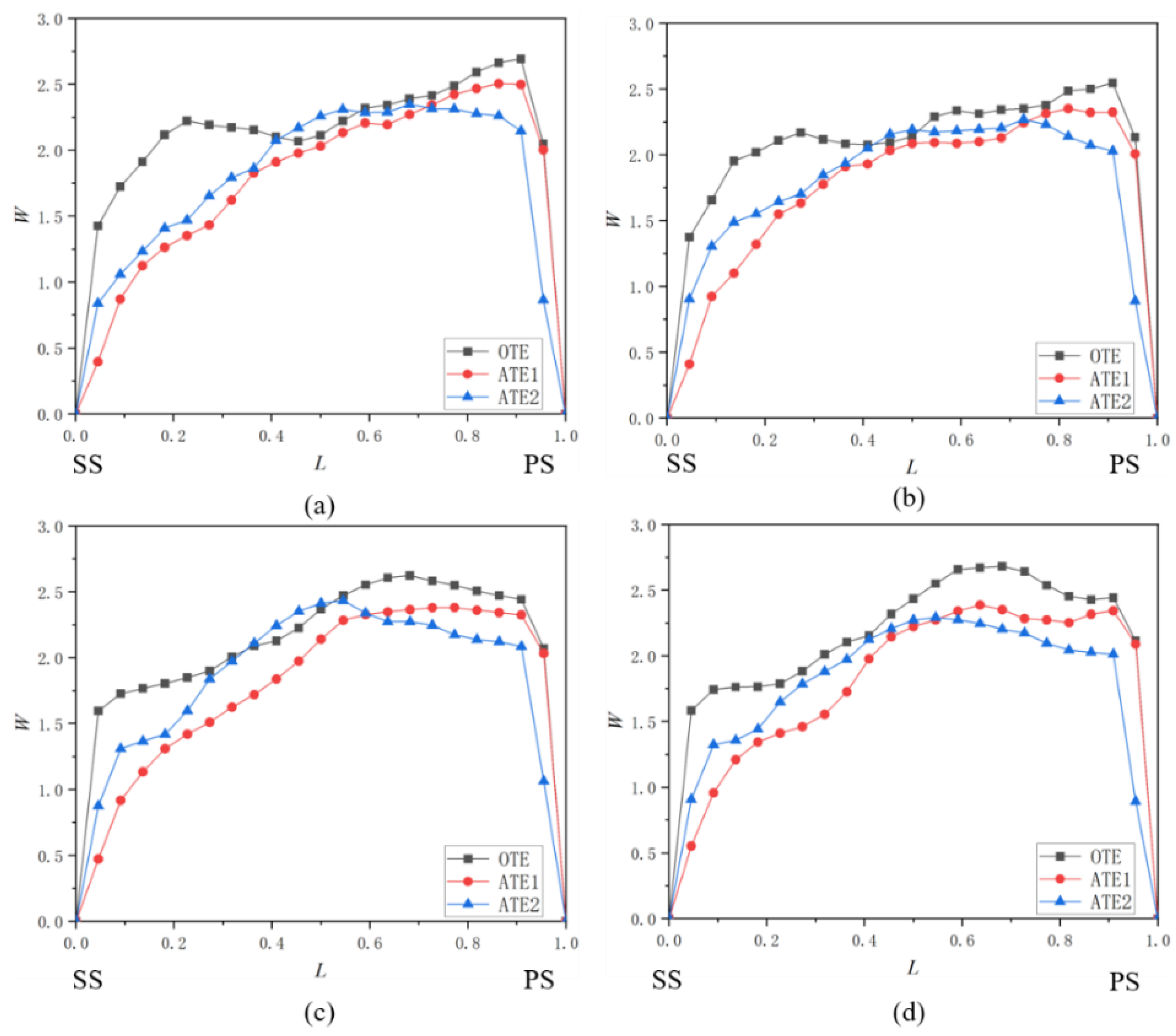
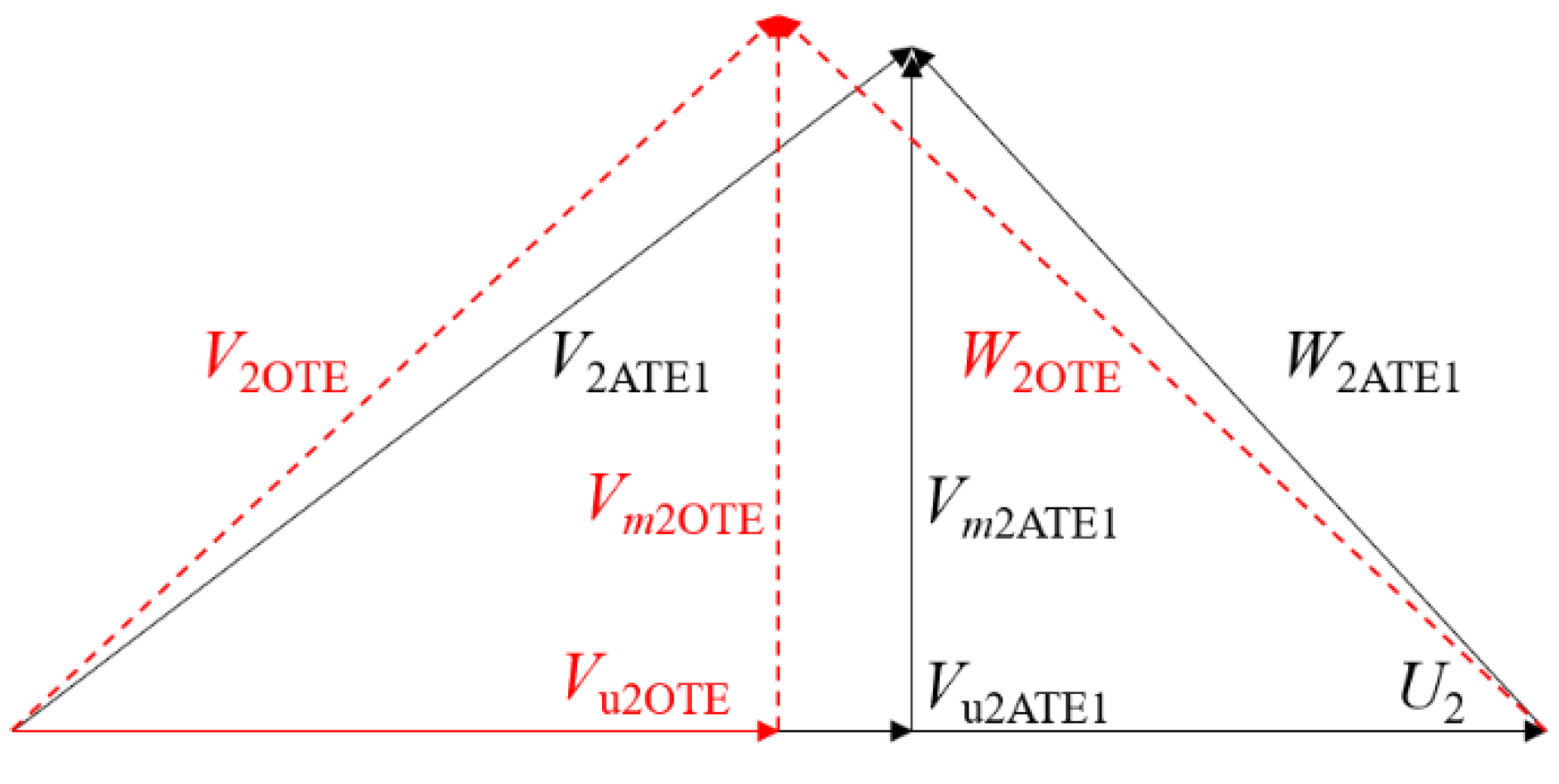
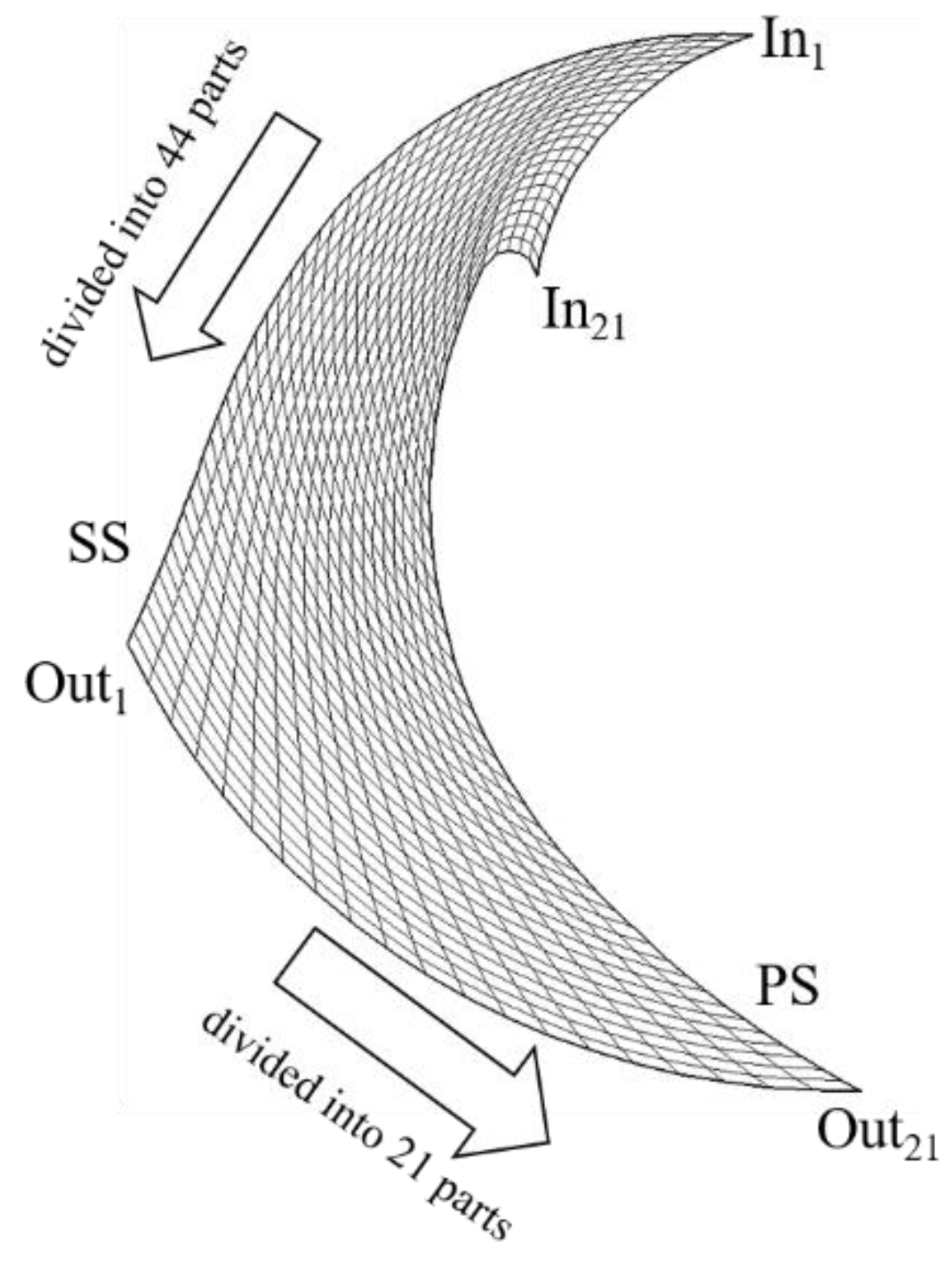

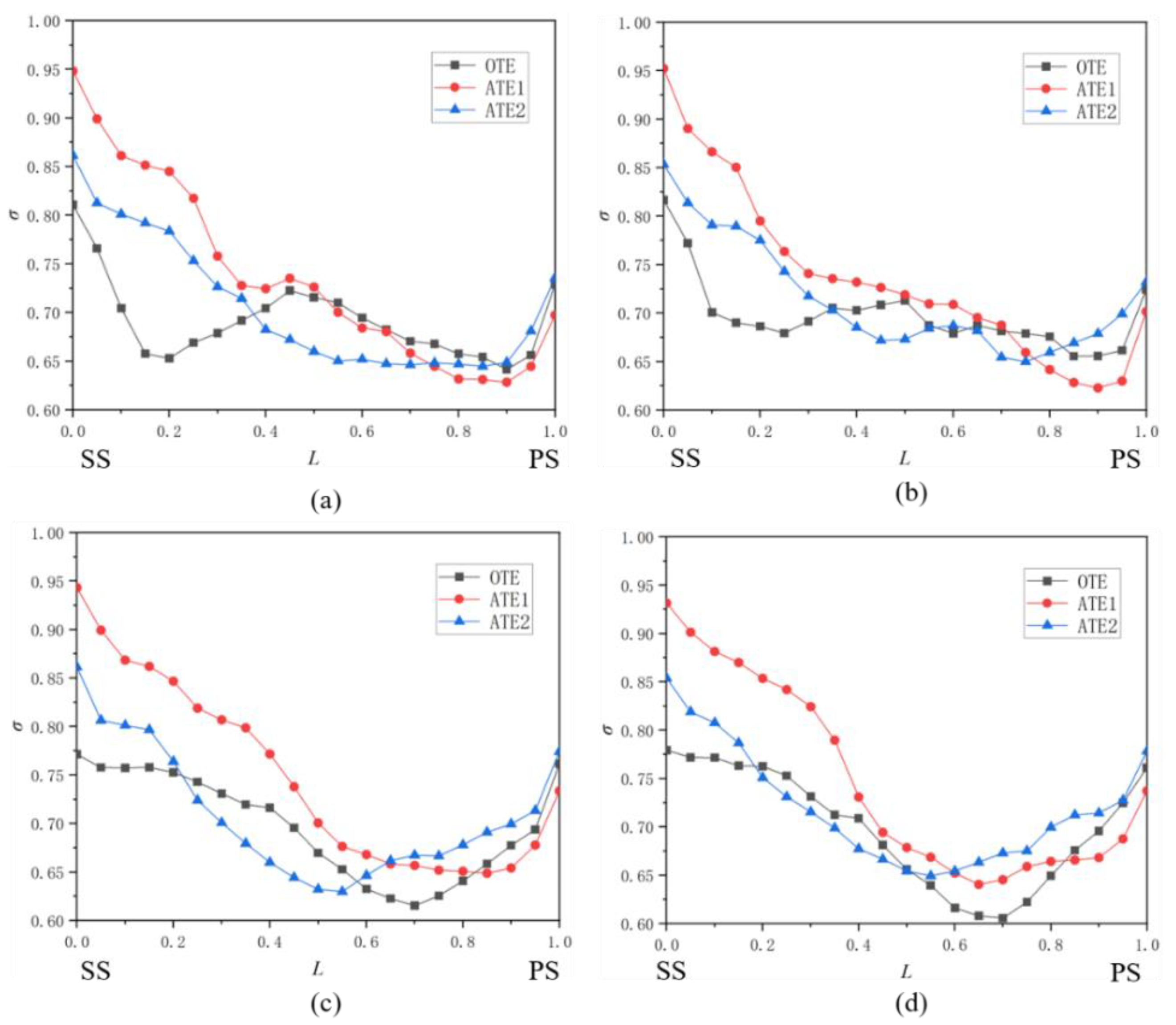

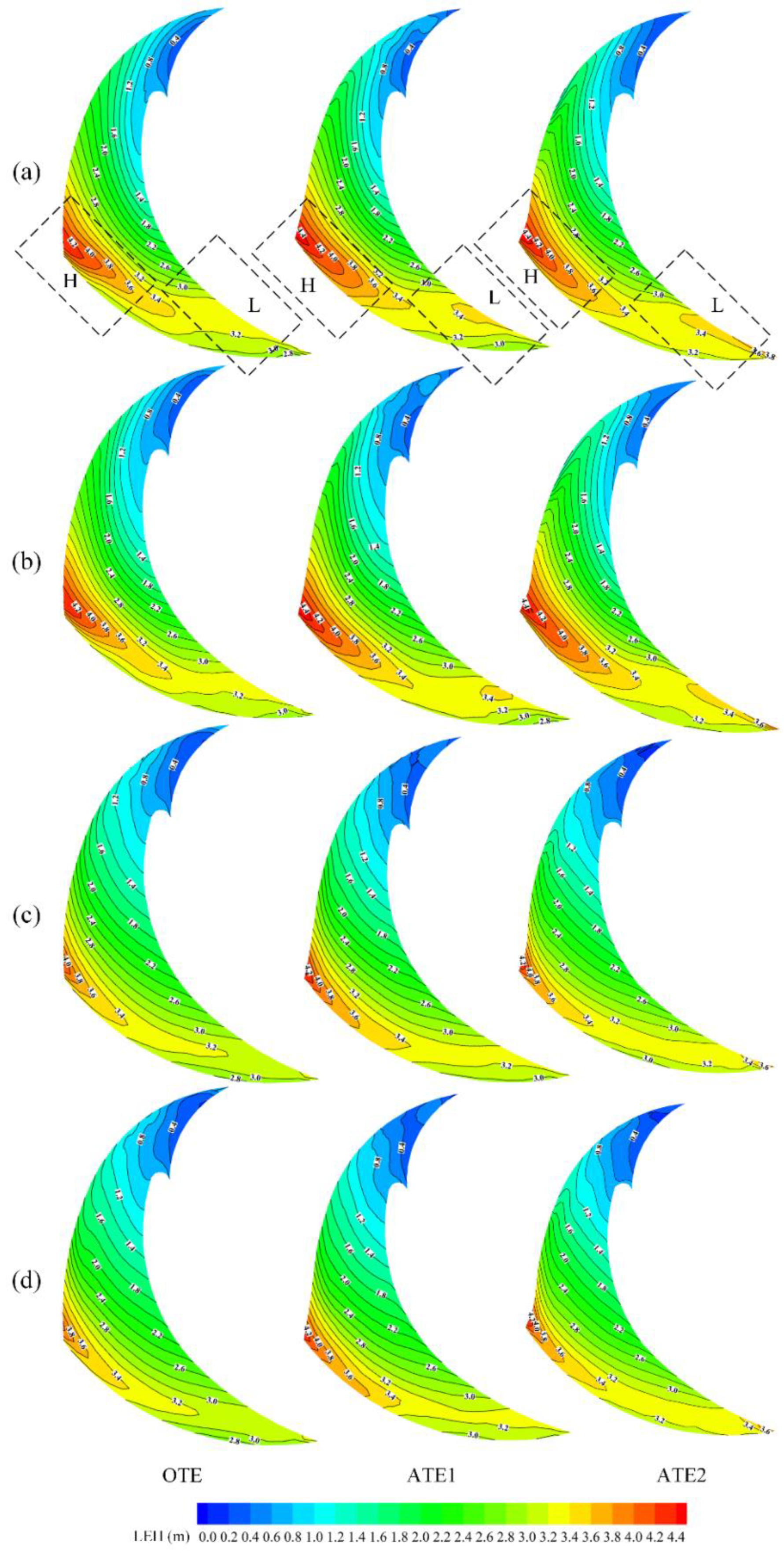
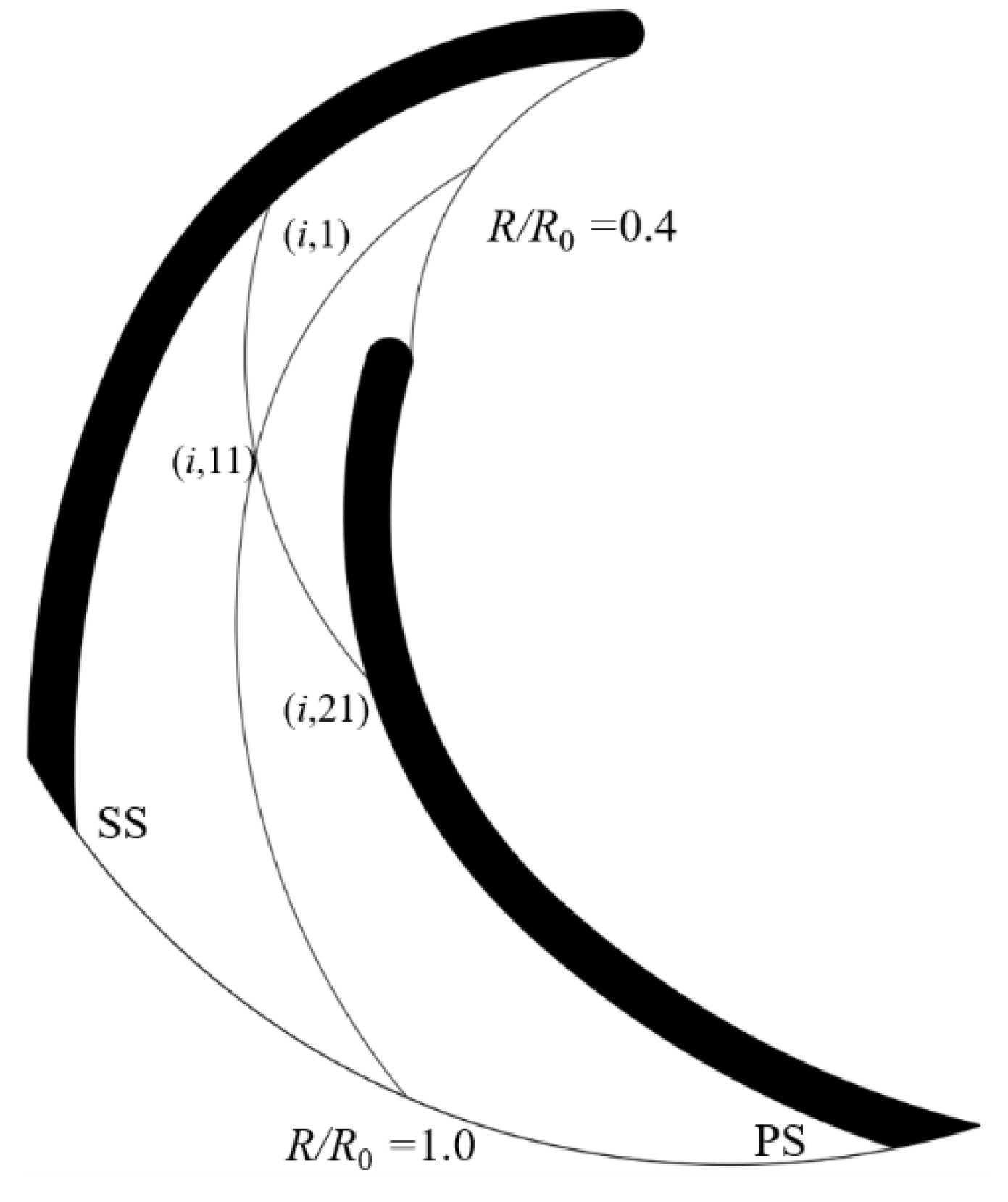
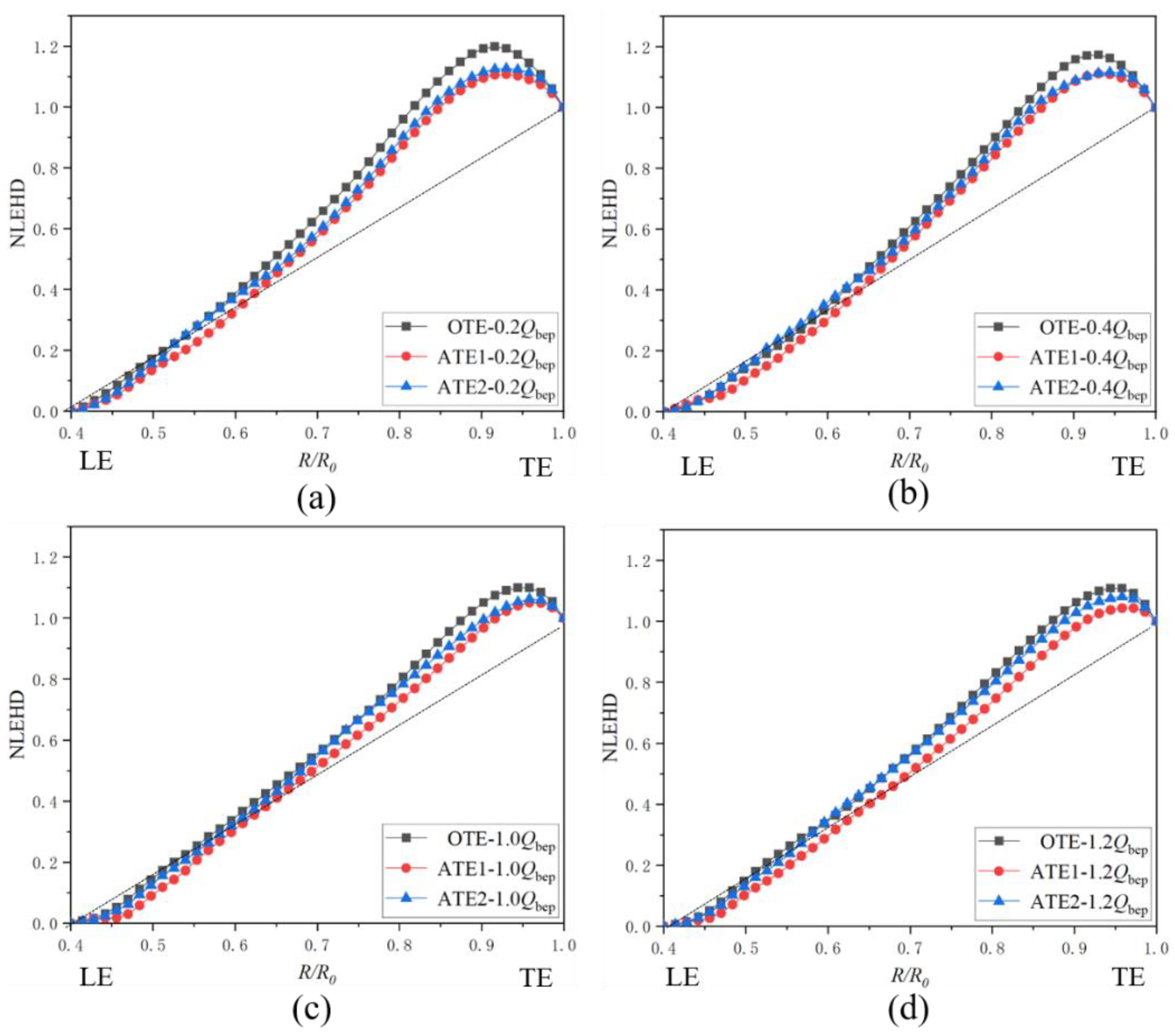
| Value | ||||
|---|---|---|---|---|
| Parameter Name | Sign | OTE | ATE1 | ATE2 |
| Inlet diameter(mm) | D1 | 56 | 56 | 56 |
| Outlet diameter(mm) | D2 | 142 | 142 | 142 |
| Blade inlet angle (°) | β1 | 18° | 18° | 18° |
| Blade outlet angle (°) | β2 | 32° | 47° | 59° |
| Blade number | Z | 5 | 5 | 5 |
| Blade height (mm) | b | 7 | 7 | 7 |
| Specific speed | ns | 23.8 | 23.8 | 23.8 |
| Blade | OTE | ATE1 | ATE2 | |||
|---|---|---|---|---|---|---|
| Parameter | Head | Efficiency | Head | Efficiency | Head | Efficiency |
| 0.2 QBEP | 2.13 m | 11.5% | 2.18 m | 12.4% | 2.17 m | 11.9% |
| 0.4 QBEP | 2.11 m | 20.1% | 2.17 m | 21.6% | 2.15 m | 21.1% |
| 1.0 QBEP | 1.74 m | 31.6% | 1.78 m | 34.1% | 1.68 m | 32.1% |
| 1.2 QBEP | 1.47 m | 29.1% | 1.48 m | 31.4% | 1.37 m | 28.1% |
Publisher’s Note: MDPI stays neutral with regard to jurisdictional claims in published maps and institutional affiliations. |
© 2022 by the authors. Licensee MDPI, Basel, Switzerland. This article is an open access article distributed under the terms and conditions of the Creative Commons Attribution (CC BY) license (https://creativecommons.org/licenses/by/4.0/).
Share and Cite
Chen, B.; Qian, Y. Effects of Blade Suction Side Modification on Internal Flow Characteristics and Hydraulic Performance in a PIV Experimental Centrifugal Pump. Processes 2022, 10, 2479. https://doi.org/10.3390/pr10122479
Chen B, Qian Y. Effects of Blade Suction Side Modification on Internal Flow Characteristics and Hydraulic Performance in a PIV Experimental Centrifugal Pump. Processes. 2022; 10(12):2479. https://doi.org/10.3390/pr10122479
Chicago/Turabian StyleChen, Bo, and Yuzhe Qian. 2022. "Effects of Blade Suction Side Modification on Internal Flow Characteristics and Hydraulic Performance in a PIV Experimental Centrifugal Pump" Processes 10, no. 12: 2479. https://doi.org/10.3390/pr10122479
APA StyleChen, B., & Qian, Y. (2022). Effects of Blade Suction Side Modification on Internal Flow Characteristics and Hydraulic Performance in a PIV Experimental Centrifugal Pump. Processes, 10(12), 2479. https://doi.org/10.3390/pr10122479




